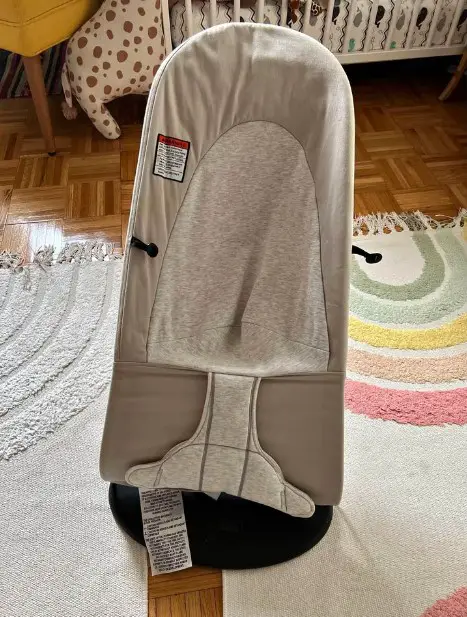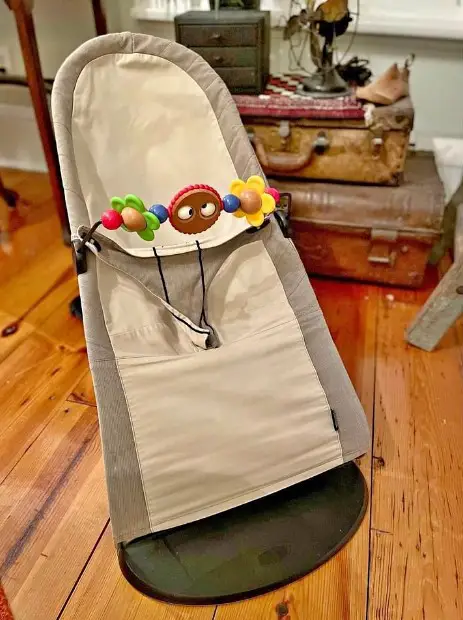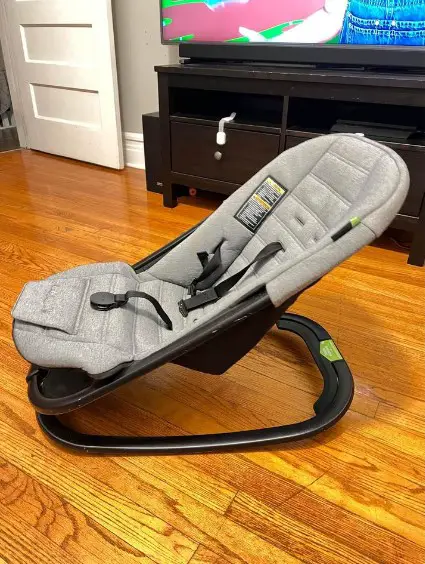Last Updated on July 16, 2023
Are bouncy swings bad for babies? This is a question that many parents ask themselves. As parents, we want to ensure our children are always safe and secure. We also want to provide them with the best possible environment to grow and develop.
Baby bouncers can be a great way to keep your baby entertained and help them develop their motor skills. However, before deciding, you should be aware of some potential risks associated with using a baby bouncer.
This article will explore are bouncy swings bad for babies, the potential risks, how to use one safely, and all the good stuff. We’ll also discuss the benefits of baby bouncers and answer some frequently asked questions.
By the end, you should have all the information needed to make an informed decision about whether or not a baby bouncer is suitable for your family. Let’s get started!
Are bouncy swings bad for babies?
Bouncy swings can be beneficial when used in moderation. As with anything, too much of a good thing can become a bad thing. Overswinging or overstimulating your baby could potentially lead to developmental delays and other issues.
The American Academy of Pediatrics (AAP) advises against using bouncy swings for more than 30 minutes at a time, and to never leave your baby unattended in one.
They also advice not to allow your baby to sleep in a bouncy swing, as this could lead to serious health problems. If your baby does fall asleep in the bouncer, you should move them to a safe sleeping area (e.g., crib) as soon as possible.
Additionally, you should always use the recommended weight limit when purchasing a baby swing.
For babies younger than 6 months, it’s best to avoid bouncy swings altogether as they can put too much strain on their developing bodies. The best way keep your baby entertained during this time is with floor play, tummy time, and interaction with parents.
Additionally, you should look for a bouncer that has straps or locks to ensure your baby cannot slip out and potentially injure themselves.
Is the Vibrating Baby Bouncer Reliable?

Vibrating baby bouncers are designed to gently rock your baby back and forth while they sit in the seat. While this can be soothing for some babies, it is essential to note that it can also cause harm if used incorrectly or excessively.
“Vibrating baby bouncers should only be used for limited periods of time and in accordance with the manufacturer’s instructions.”, says Dr. Teja Dyamenahalli, a board-certified pediatrician. “Parents should also ensure that the seat is securely fastened to a sturdy surface to prevent any chance of tipping or falls.”
It is important to monitor your baby while they are in the bouncer and ensure that the vibrations are not too powerful or last for too long.
“If you notice any signs of discomfort or distress, it is best to stop using the vibrating function immediately”, added Teja.
Why are baby bouncers bad?
Baby bouncers can be dangerous if used improperly or excessively, as they can cause excessive movement, leading to injury or even death in some cases. Additionally, when babies are placed in a baby bouncer, their heads may flop forward and put pressure on their necks which could restrict breathing and cause suffocation.
Dr. Teja also reminds parents that baby bouncers are not suitable for sleeping. Babies should always be put down to sleep in a safe place such as a crib, bassinet or flat surface.
The AAP also recommends that supervise their baby while in the bouncer and not leave them unsupervised for more than a few minutes.
Furthermore, when babies are placed in a baby bouncer, they may not have enough support for their hips, which could lead to hip dysplasia (a condition where the hip joint does not correctly form).
The Risks that Come With It
There are several risks associated with using a baby jumper:
Excessive movement:
When placed in a baby jumper, infants may experience excessive movement, possibly leading to injury or even death.
Restriction of airways:
When placed in a baby jumper, an infant’s head may flop forward and put pressure on the neck, which could restrict breathing and cause suffocation.
Hip dysplasia:
When placed in a baby jumper, an infant may not have enough support for their hips, which could lead to hip dysplasia (a condition where the hip joint does not correctly form).
Strangulation hazards:
Some models of baby jumpers come with straps that wrap around the child’s waist or chest area, which could pose strangulation hazards if not used correctly.
Falls:
If an infant is left unattended while sitting in a baby jumper, they may fall out of the seat due to lack of supervision or improper use of safety straps/harnesses.
Tips for using it Safely

To ensure your child’s safety while using a baby jumper, you must follow these guidelines:
- Always read the instructions carefully before using any equipment involving your child’s safety, such as car seats, strollers, and jumpers.
- Ensure your child is securely strapped into the seat before leaving them unattended, even for short periods, as they may become restless and try to climb out of the heart without supervision.
- Do not leave your child unattended for long periods, as this increases the risk of falls from the seat due to lack of supervision or improper use of safety straps/harnesses.
- Ensure you place your child’s feet firmly on the floor before putting them into the seat so they do not slip out easily when jumping up and down inside it.
- Never leave toys or other objects inside the seat, as these can pose choking hazards if swallowed by your child.
- If you notice any signs of discomfort, such as redness around your child’s face or neck area, after using the jumper, then stop using it immediately.
Benefits of Baby Bouncers:
Although there are potential risks associated with using a baby bouncer, there are also several benefits associated with its use, such as:
Improved motor skills development:
By bouncing up and down inside their seats, infants will improve their gross motor skills, such as balance, coordination, strength, agility, etc. This helps them prepare for more advanced physical activities later on, such as crawling, walking, running, etc.
Stimulated senses:
By being exposed to different sounds, textures, shapes, colors, etc . through toys attached to their seats, infants will stimulate all five senses helping them learn about their environment faster than usual.
Improved concentration:
Sitting inside their seats allows infants more time for focus, allowing them better concentration levels than usual, thus helping them learn faster about new things around them.
Types Of Baby Jumpers

When it comes to bouncy swings for babies, there are various options available.
Baby bouncers:
Baby bouncers are usually soft fabric seats sewn onto a frame that responds to your baby’s kicking motion by bouncing up and down.
Jumpers:
Jumpers are similar to bouncers but have an attached toy bar with toys for your baby to play with while they jump.
Swings:
Swings tend to be heavier and larger than baby bouncers and are mechanically powered, rocking your baby back and forth, side to side, or a combination of both.
No matter which type you choose, all these products can provide comfort and entertainment for your little one. When shopping for the perfect bouncy swing for your baby, consider features such as adjustable speeds, music and sound effects, reclining positions, portability, and safety ratings.
FAQS
What Are The Alternatives?
Suppose you decide against buying a traditional jumper. In that case, plenty of alternatives are available, including activity centers like play mats and gyms where babies can lie down and explore different textures and shapes without having too much freedom and movement like traditional jumpers offer.
Starting and Ending Age of using baby bouncers or swing?
Generally, swings are suitable for babies and toddlers from the age of 0 to 1 years old. It is essential to check the manufacturer’s instructions to ensure your chosen swing is appropriate for your child’s age and weight.
Most swings will have an adjustable seat position, so they can be extended as your baby grows. It is recommended that you upgrade to a bigger size when your baby’s feet cannot reach the footrest easily or if their head empties above the top edge of the seat back.
It is always best practice to supervise any child under four with a bouncy swing and ensure they do not exceed the specified maximum weight limit. Straps and harnesses are securely fastened before your little one is in the swing.
How to manage if my baby has reflux?
Managing your baby with reflux on a bouncy swing can be tricky. Keeping your baby upright while in the swing is essential, as this can help reduce their symptoms. You may also want to limit your baby’s time in the swing and try to use other products, such as an automatic baby swing, bouncer, or hammock instead.
Additionally, you should avoid leaving your baby in a car seat for extended periods and ensure that when using things like slings and bouncy seats, you keep your baby’s head and body straight.
How to break the habit of my baby being in a bouncy swing?
It can be challenging to break the habit of your baby sleeping in a bouncy swing. However, there are some steps you can take to help transition your baby out of the swing and into a crib or bassinet.
First, attach toys securely to the swing to prevent objects from falling and hurting your child. It is also essential to stay informed of all recalls relating to baby swings.
Second, set a time limit for when your baby is allowed in the swing. This will help them get used to being in other places for sleep and naps. You should also avoid giving your baby a comfort object in the swing, as this could make it harder for them to adjust.
Third, reduce the rhythmic motion of the swing so that it does not lull your baby into sleep. This will help keep them awake and alert while they are in it.
Finally, if your baby falls asleep in the swing, move them into a crib or bassinet as soon as possible.
Following these steps, you can help transition your baby from its bouncy swing habit into safer sleeping arrangements.
Wrapping Up
Thanks for reading this guide on are bouncy swings bad for babies. We hope you’ve found this guide helpful and informative.
Bouncy swings are a great way to keep your baby entertained and comfortable, but always be sure to follow safety guidelines and age-appropriate use.
Additionally, if you find that your baby has become dependent on the bouncy swing for sleep, gently transition them into safer sleeping arrangements.
Remember to always stay informed of recalls, properly secure toys and objects, and set a time limit for using the swing. Doing all this will help ensure your baby’s safety and wellbeing when using any type of bouncy swing. Finally, take comfort in knowing that these products have been thoroughly tested for their quality, durability, and safety.
Thank you for reading and stay safe!
Sources:
- https://www.cnet.com/health/parenting/how-to-break-your-babys-habit-of-sleeping-in-a-swing/
- https://reflux.org.au/information/reflux-management-tips/
- https://www.healthychildren.org/English/tips-tools/ask-the-pediatrician/Pages/What-is-the-safest-sleep-solution-for-my-baby-with-reflux.aspx
- https://infinitypediatrics.ca/wp-content/uploads/2015/01/Infinity-Pediatrics-Reflux
Sharing is caring!

Dr. Leah Alexander is a board-certified general pediatrician who has been in practice for over 20 years. She began working as a pediatrician at Elizabeth Pediatric Group of New Jersey in 2000. Since 2005, she has been working as an independently contracted pediatrician with Medical Doctors Associates at Pediatricare Associates of New Jersey. Read more

